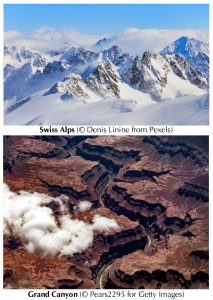 Scientists have long sought to understand the properties of glassy materials, which solidify without crystallizing when cooled. One approach has been to study their so-called energy landscapes—energy functions in an abstract, high-dimensional space where every point corresponds to a single arrangement of atoms.
Scientists have long sought to understand the properties of glassy materials, which solidify without crystallizing when cooled. One approach has been to study their so-called energy landscapes—energy functions in an abstract, high-dimensional space where every point corresponds to a single arrangement of atoms.
MRSEC researchers studying three different types of glasses using simulation found these landscapes resembled the meandering canyons in the Grand Canyon (with many low-lying states near each other, forming an almost one-dimensional arrangement). This is contrary to earlier work that considered the landscape to be much less easily navigable, more like the Swiss Alps.
This discovery may enable new approaches to simulating glasses to solve current mysteries in glass physics, and provide new insights into the nature of glass solidification, inclduing why it is so similar in very different materials. Seed funds for this work were provided by the MRSEC.
What Has Been Achieved: The PIs explored the potential energy landscapes of three different glassy and glass-forming model systems in simulation; discovering that the lowest energy glassy states of the system have an unexpected arrangement in high-dimensional configuration space. Specifically, rather than being randomly scattered and separated by steep and tall energy barriers (akin to the lowest points in an Alpine landscape), the states were arranged into quasi-one-dimensional clusters, crumpled into a fractal shape, with only small barriers between them (akin to the low-lying points along the floor of the Grand Canyon). Remarkably, the shapes of these clusters of glassy states were nearly indistinguishable in the three different models, suggesting they may be a ubiquitous feature of glassy materials.
Importance of the Achievement: This remarkable discovery suggests that it is (computationally) easier than previously believed to locate the lowest energy states of glassy systems—one can just follow the canyon to lower energy—rather than using existing annealing or random walk strategies. Such low energy states are at the heart of current debates about the thermodynamics of glasses, such as the Kauzmann Paradox. More generally, future work to understand the origin of this canyon structure could provide deep insights into the origin of the still poorly understood origin of glassy physics.
How is the achievement related to the IRG, and how does it help it achieve its goals? This work is informed by the studies of myriad glassy systems in IRG1, and partially supported by funds from a 2020 MRSEC SEED project. Future work will seek to connect the universal failure behaviour seen in these materials by the IRG1 team to the canyons structures we have found.
Where the findings are published: Thirumalaiswamy, Amruthesh, Robert A. Riggleman, and John C. Crocker. “Exploring canyons in glassy energy landscapes using metadynamics.” Proceedings of the National Academy of Sciences 119.43 (2022): e2210535119. https://doi.org/10.1073/pnas.2210535119
